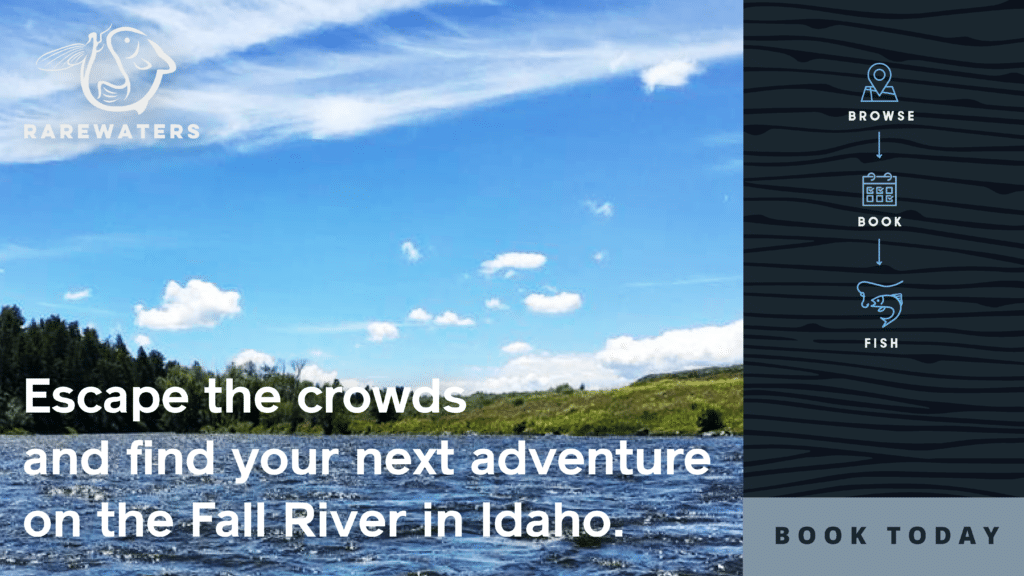Shadow Casting for Show
After bait and spinner fishing my whole life, I switched to fly fishing in my early college years. There’s a story I told my young sons about one of my early catches in the Eastern Sierra Nevada mountains. Based on the excitement of having just learned to cast and watching the recently-released movie A River Runs Through It, my approach to casting at the time was to try and keep my line in the air as long as possible. “Shadow Casting,” they called it in the movie, explaining that the technique allowed a fish to watch the fly in the air and anticipate its landing. I later learned it was fake movie magic, but I thought it looked cool at the time. So, I stood along the Lower Owens River at dusk, gleefully watching the extraneous looping of my line highlighted in the sunset.
At some point, I fully intended to drop the fly into the river, where I knew for sure a large brown trout eagerly awaited the delicious fly it spotted traversing the river’s airspace. I picked my spot behind a boulder and squared up with one last back cast.
On my rod’s forward motion, my line snagged. A tree, I presumed. That’s the natural result of Shadow Casting. However, when I turned to find what tree had swallowed my fly, my rod tugged vigorously. Like a trout, but higher. I looked up, and there it was. A Cliff Swallow was flying away with my line. It ate my fly mid-flight. I matched the hatch perfectly. Stunned momentarily as my line extended to the sky, I did the only natural thing. I set my line.
“Bwawk!” I heard skyward.
I got him!
Fishing with Dinosaurs
For those of you who’ve not hooked a Swallow on a fly, or any other bird species, they are surprisingly good fighters. The chestnut-cheeked Petrochelidon pyrrhonota, as we refer to them in the fly-fishing community, is distinguished by dark brownish plumage covering their backs and wings and a white belly. They only reach five to six inches in length, but I like to measure them by their pointed wingspan, which is closer to twelve inches. But it’s their weight class that’s most astounding. At less than an ounce, pound for pound, the Swallow fights stronger than trout. I considered switching from trout to birds. Imagine catching a Peregrine Falcon on a dry fly! Or a Bald Eagle!
The Swallow soared, taking my line into its backing before I gained on it. Unlike fighting a trout, birds yank your rod in all directions, performing various aerial acrobatics. It did loop-to-loops. It curved and swooped and circled tightly. It even dive-bombed my head, causing me to slip and fall into the dirt. I always kept my rod tip high, even as I ducked for cover on its second dive bomb.
Finally, completely exhausted, the bird landed about 30 feet away. Instead of dragging the tired bird to me, a practice looked down upon in the sport; I walked to the bird while reeling in the slack line. That’s when I realized I had no idea how to remove a fly from a bird’s beak. Do you wet your hands first? I gently placed my net over the bird. We shared a moment. This is why we fish, that pure connection to the natural world. I reached for my forceps. As subtle as it was, my movement scared the bird, and the creature burst with energy, flapping hard against the net. Luckily, it spit the fly out in the process. I lifted the net and thanked the bird for its gift.
“You are free,” I tenderly called to it.
“Bwawk,” it said in return.
I watched the beautiful Swallow return to flight, thanking it for its momentary gift of connecting me to the wild.
I finished the story and expected my sons to laugh at the idea of their dad reeling in a bird from the sky. Crickets. Instead, they ganged up on me, asking…
“Dad, how long ago was that?”
“It was a long time ago. You weren’t born yet.”
“How old are you?”
“I’m pretty old.”
“Was it scary fishing with the dinosaurs?”

Roger W. Thompson is the nationally acclaimed author of We Stood Upon Stars and My Best Friend’s Funeral, as well as an avid fly-fisherman. His ability to write about fishing and adventure while connecting to the deepest meanings of the human experience has earned him the nickname “The River Bishop.” Roger lives with his wife and two teenage sons in his coastal hometown of Ventura, California, where they surf, skate, snowboard, and build furniture together. Roger will be writing an exclusive series of essays for RareWaters.com over the coming weeks and months. We hope they inspire and encourage you.
Check out a few of our properties that hopefully have hungrier trout than swallows!








